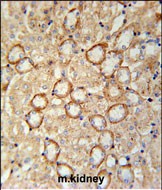CRUM2 Antibody (C-term)
Affinity Purified Rabbit Polyclonal Antibody (Pab)
- SPECIFICATION
- CITATIONS: 1
- PROTOCOLS
- BACKGROUND

Application
| WB, IHC-P, E |
|---|---|
| Primary Accession | Q5IJ48 |
| Other Accession | Q80YA8, NP_775960.4 |
| Reactivity | Human, Mouse |
| Host | Rabbit |
| Clonality | Polyclonal |
| Isotype | Rabbit IgG |
| Calculated MW | 134265 Da |
| Antigen Region | 1258-1285 aa |
| Gene ID | 286204 |
|---|---|
| Other Names | Protein crumbs homolog 2, Crumbs-like protein 2, CRB2 |
| Target/Specificity | This CRUM2 antibody is generated from rabbits immunized with a KLH conjugated synthetic peptide between 1258-1285 amino acids of human CRUM2. |
| Dilution | WB~~1:1000 IHC-P~~1:50~100 E~~Use at an assay dependent concentration. |
| Format | Purified polyclonal antibody supplied in PBS with 0.09% (W/V) sodium azide. This antibody is purified through a protein A column, followed by peptide affinity purification. |
| Storage | Maintain refrigerated at 2-8°C for up to 2 weeks. For long term storage store at -20°C in small aliquots to prevent freeze-thaw cycles. |
| Precautions | CRUM2 Antibody (C-term) is for research use only and not for use in diagnostic or therapeutic procedures. |
| Name | CRB2 (HGNC:18688) |
|---|---|
| Function | Apical polarity protein that plays a central role during the epithelial-to-mesenchymal transition (EMT) at gastrulation, when newly specified mesodermal cells move inside the embryo (By similarity). Acts by promoting cell ingression, the process by which cells leave the epithelial epiblast and move inside the embryo to form a new tissue layer (By similarity). The anisotropic distribution of CRB2 and MYH10/myosin-IIB at cell edges define which cells will ingress: cells with high apical CRB2 are probably extruded from the epiblast by neighboring cells with high levels of apical MYH10/myosin-IIB (By similarity). Plays a role in the maintenance of retinal neuroepithelium organization, structural integrity, adhesion, photoreceptor polarity and retinal photoreceptor layer thickness (By similarity). May play a role in determining the length of cone photoreceptor outer segments and proliferation of late-born progenitor cells (By similarity). Also required for maintenance of the apical polarity complex during development of the cortex (By similarity). Inhibits gamma-secretase- dependent cleavage of APP and secretion of amyloid-beta peptide 40 and amyloid-beta peptide 42, and thereby inhibits gamma-secretase-dependent Notch transcription (PubMed:20299451). |
| Cellular Location | [Isoform 1]: Apical cell membrane {ECO:0000250|UniProtKB:Q80YA8}; Single-pass type I membrane protein. Cytoplasm {ECO:0000250|UniProtKB:Q80YA8}. Cell junction {ECO:0000250|UniProtKB:Q80YA8}. Note=O-glucosylation is required for localization at the apical plasma membrane (By similarity). Distributed in a complex anisotropic pattern on apical cell edges: the level of CRB2 on a cell edge is inversely correlated with the level of MYH10/myosin-IIB (By similarity). {ECO:0000250|UniProtKB:Q80YA8} |
| Tissue Location | Expressed in glomeruli, podocytes of the glomerular capillary loops, and parietal glomerular epithelial cells in the kidney (at protein level) (PubMed:27942854, PubMed:29473663). Expressed in retina, fetal eye and brain (PubMed:15851977). Also expressed in kidney, RPE/choroid, and at low levels in lung, placenta, and heart (PubMed:15851977). |

Provided below are standard protocols that you may find useful for product applications.
Background
May play a role in polarized cells morphogenesis.
References
If you have used an Abcepta product and would like to share how it has performed, please click on the "Submit Review" button and provide the requested information. Our staff will examine and post your review and contact you if needed.
If you have any additional inquiries please email technical services at tech@abcepta.com.














 Foundational characteristics of cancer include proliferation, angiogenesis, migration, evasion of apoptosis, and cellular immortality. Find key markers for these cellular processes and antibodies to detect them.
Foundational characteristics of cancer include proliferation, angiogenesis, migration, evasion of apoptosis, and cellular immortality. Find key markers for these cellular processes and antibodies to detect them. The SUMOplot™ Analysis Program predicts and scores sumoylation sites in your protein. SUMOylation is a post-translational modification involved in various cellular processes, such as nuclear-cytosolic transport, transcriptional regulation, apoptosis, protein stability, response to stress, and progression through the cell cycle.
The SUMOplot™ Analysis Program predicts and scores sumoylation sites in your protein. SUMOylation is a post-translational modification involved in various cellular processes, such as nuclear-cytosolic transport, transcriptional regulation, apoptosis, protein stability, response to stress, and progression through the cell cycle. The Autophagy Receptor Motif Plotter predicts and scores autophagy receptor binding sites in your protein. Identifying proteins connected to this pathway is critical to understanding the role of autophagy in physiological as well as pathological processes such as development, differentiation, neurodegenerative diseases, stress, infection, and cancer.
The Autophagy Receptor Motif Plotter predicts and scores autophagy receptor binding sites in your protein. Identifying proteins connected to this pathway is critical to understanding the role of autophagy in physiological as well as pathological processes such as development, differentiation, neurodegenerative diseases, stress, infection, and cancer.


